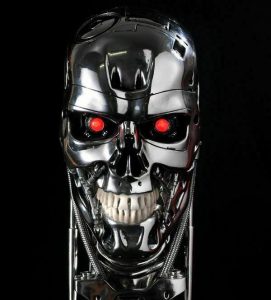Respecting Quality
Note: The following contains spoilers for the entire Terminator franchise.
There are six Terminator movies.
 In the first movie, The Terminator (1984), a Terminator (Arnold Schwarzenegger) – a cyborg – is sent back from the future to kill a woman, Sarah Connor (Linda Hamilton), who’ll give birth to the saviour of humanity, John Connor, in a fight against the sentient artificial intelligence, Skynet, and the machines it commands. A resistance fighter, Reese (Michael Biehn) is sent back to protect Sarah, but inevitably she must fight for her own life.
In the first movie, The Terminator (1984), a Terminator (Arnold Schwarzenegger) – a cyborg – is sent back from the future to kill a woman, Sarah Connor (Linda Hamilton), who’ll give birth to the saviour of humanity, John Connor, in a fight against the sentient artificial intelligence, Skynet, and the machines it commands. A resistance fighter, Reese (Michael Biehn) is sent back to protect Sarah, but inevitably she must fight for her own life.
Sarah Connor’s transformation from terrified waitress to tough, hardened soldier in Terminator 2: Judgement Day (1991) is totally believable. The circumstances have forced her to change, and seek out training and guidance wherever she can. T2 also introduces Schwarzenegger now as a good Terminator, and a menacing Robert Patrick as the antagonist liquid Terminator. We also get a cool friendship that develops between the Arnie Terminator and the teenage John Connor (Edward Furlong).
Both movies remain classics. Their characters have become pop culture icons.
I’ve always thought Terminator 3: Rise of the Machines (2003) is maligned. It’s not the movie its predecessors are, but that’s a high standard to meet. The story tries to deal with the closed premise that exists in this franchise, i.e., once the saviour is saved, then that should mean the end of Skynet. One of the bigger issues is the absence of Sarah Connor. While John Connor (now played by Nick Stahl) is humanity’s saviour, Sarah is the heart of the franchise. But Linda Hamilton didn’t want to return, so they wrote her out – killed her. Grrr. Through two movies she fought for her life … only to die off-screen.
Terminator Salvation (2009), now with Christian Bale playing John Connor, also tries to deal with the closed premise by reshaping what the future is meant to be. The story is remarkably bland. Although it was meant to springboard a new trilogy, the movie flopped and the trilogy was quashed.
Terminator: Genisys (2015) came next. We again had Arnold Schwarzenegger playing the Terminator, while Game of Thrones’ Emilia Clarke took up the mantle of Sarah Connor. I like Clarke, but she is woefully miscast as a gun-toting action hero. Jai Courtney now plays Reese.
In Terminator, Michael Biehn’s Reese is thin, malnourished, and strung out. He’s what you’d expect given he’s born in a time Machines are dominant and he’s been fighting for survival his whole life. Courtenay looks like he’s been drinking protein shakes, working out at the gym under a regimented program, and that the most stressful thing he’s had to deal with is what sort of coffee to order at the local cafe. It’s important to compare, because one property gets who Reese is meant to be.
The story at least tries to deal with all the temporal incursions by going all Back to the Future II (1989) as the characters initially weave their way through the events of the first movie. But it then becomes an overly complicated mess. John Connor – now played by Jason Clarke – is the villain. Why? Simply because nobody would expect it since John Connor is actually meant to be a hero? Cheap heat. Yech. As with Salvation, Genisys was meant to start a new franchise, but bombed.
So now we get Terminator: Dark Fate (2019). John Connor is killed in the opening minutes. Its mission complete, the Terminator responsible goes off and makes a life for himself hanging curtains, marrying, owning a dog, and taking on the name of ‘Carl’. I am not making this shit up. A new saviour, Dani Ramos (Natalia Reyes), is appointed. Linda Hamilton is back. A different Terminator, REV-9 (Gabriel Luna), is introduced. There’s also a hybrid resistance fighter, Grace (Makenzie Davis). Recycle the plot of the first movie.
I cite the Terminator franchise as a way of charting a series that began with an original premise, characters we cared about and who changed over the journey, and amazing action that was always kept in context with the situation, but which then deteriorated into one-dimensional characters, derivative storytelling, ridiculous plotting, and over-the-top action. Is it any wonder the later movies failed?
The same occurred with the Alien franchise. The first movie, Alien (1979) is this brilliantly tense claustrophobic sci-fi horror. In the sequel, Aliens (1986), the action is ramped up, we learn more about the aliens, Ripley takes this amazing journey to become a kickass warrior, and we’re introduced to new characters who we care about. These two movies are awesome.
Alien 3 (1992) is a rehash that – like Terminator 3 – kills much-loved characters off-screen. The alien whittles its way through a rank of meaningless supporting characters. Do we care about any of them? Well, given these supporting characters are rapists and murderers, I’m on the alien’s side on this one. There’s a semi-interesting subplot about the alien queen, good performances by Sigourney Weaver and Lance Henricksen, but the story is so much meh. Are we given anything new? No. It’s not horrible. It’s a solid but unspectacular rehash of the first movie.
The fourth installment in the franchise, Alien Resurrection (1997), is pretty funny. The problem is it’s not meant to be funny. Then there’s two Alien vs Predator films – Alien vs Predator (2004) and Alien vs Predator: Requiem (2007) – that nobody really cared about. The director of the original movie, Ridley Scott, then returned to helm two movies exploring the aliens’ origin in Prometheus (2012) and Alien: Covenant (2017). I admire Scott’s vision but these movies complicate an origin story that didn’t need to be complicated.
Ratings today get skewed because lots of franchises bring in existing fanbases desperate to see their favourite characters brought to life, and whose enthusiasm encourages them to be either forgiving or oblivious.
Ultimately, the franchises are found out, as has happened with Terminator, Alien, the original Batman series, the new Star Wars universe, JJ Abrams’s Star Trek, the Die Hard series, etc. This is a big list.
Sometimes, it doesn’t even take sequels for audiences to make that call. The Ghostbusters (2016) reboot fizzled. The DC universe has struggled to get going, and is now in development hell. Universal Pictures’ attempt to launch a Dark Universe with The Mummy (2017) imploded. Most recently, Charlie’s Angels (2019) bombed.
We can cite [REASONS] these movies didn’t work, but the paramount reason is simply this: quality.
Audiences will watch good stories. They’ll engage in good stories. They don’t care if those stories are different. They don’t care who’s in those stories.
Last week I cited Logan (2017) and The Joker (2019) as two stories that are different, but work. I can’t think of many other modern-day blockbusters which are compelling in the same way.
Audiences also want characters to whom they can connect. They want characters who take them on a journey. They want characters who are relatable.
If these precepts of storytelling aren’t met, audiences turn off (as has happened with Star Trek, Star Wars, etc.) or just don’t show enough interest to warrant continuation (The Mummy, Ghostbusters, etc.).
This gauge of quality applies to every story – from franchise films to standalone films to arthouse films to television series to novels to short stories and to whatever else contains a story. That’s art. While there’s always a level of subjectivity, there’s also a threshold which, when crossed, will predominantly qualify something as good or bad.
Good movies bring people in.
Bad movies don’t.
It’s a pretty simple formula.
